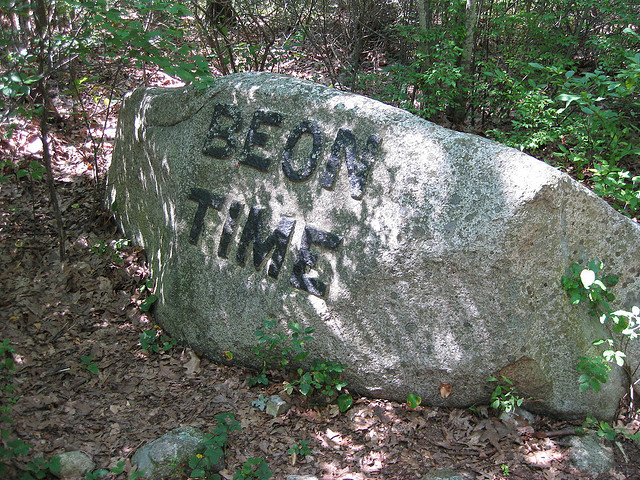15 May 2016
The Babson Boulders of Dogtown
Roger Babson had a problem. His family thought he was crazy or felonious or both. He had started to carve mottoes in to the boulders which lay in the fields near the long abandoned settlement of Dogtown close to his home in Gloucester, Massachusetts.
Babson was later to write in his autobiography: My family says that I am defacing the boulders and disgracing the family with these inscriptions, but the work gives me a lot of satisfaction, fresh air, exercise and sunshine. I am really trying to write a simple book with words carved in stone instead of printed paper. Besides, when on Dogtown common, I revert to a boyhood which I once enjoyed when driving cows there many years ago.
By 1930 Babson was in his fifties and a renowned entrepreneur and business theorist, the scion of a ten generation dynasty based in Gloucester. He went to MIT and founded Babson’s Statistical Organisation which analysed business reports and statistics for clients. It perseveres to this day as Babson-United Inc. Perhaps his decision to carve mottoes on to the rocks near his home represented an attempt to boil down his knowledge in to easily digestible, pithy sayings.
In fact his desire to deface was more than a mid-life craving to carve mottoes in to stone, to leave behind platitudes for later generations. The project was undertaken during the Great Depression and it was Babsons intent to help out the unemployed stonecutters of Gloucester by giving them work. Perhaps a sense of responsibility also led him to this act of charity – he had, after all, predicted the crash with alarming prescience.
On October 5 1929 Babson had given a speech. In it he had proclaimed that Sooner or later a crash is coming, and it may be terrific. That very day the market declined by 3% and it became known as the Babson Break. Yet more was to come – within two weeks the London Stock Exchange crashed. A short while later $14 billion value was wiped off the stock market value on October 29 alone. The Wall Street Crash, as predicted by Babson, had come to pass.
Babson died in 1967 at the age of 92. The fields in which he carved his rocks are gone but the boulders remain. Now they (24 all told) lie in what is a young but somewhat overgrown forest. Yet his memory remains as the area has been turned in to The Babson Boulder Trail and is used by many for hiking and mountain-biking. It can be difficult to find some of the boulders but once discovered their inscriptions – and their plain but sensible messages – are still unmistakably visible.
You may think that Babson's mottoes state the obvious but as Einstein once said - if you can't explain it to a six year old, you don't understand it yourself.
Picture of Babson - Wikipedia
Use Your Head - Flickr User iandavid
By 1930 Babson was in his fifties and a renowned entrepreneur and business theorist, the scion of a ten generation dynasty based in Gloucester. He went to MIT and founded Babson’s Statistical Organisation which analysed business reports and statistics for clients. It perseveres to this day as Babson-United Inc. Perhaps his decision to carve mottoes on to the rocks near his home represented an attempt to boil down his knowledge in to easily digestible, pithy sayings.
In fact his desire to deface was more than a mid-life craving to carve mottoes in to stone, to leave behind platitudes for later generations. The project was undertaken during the Great Depression and it was Babsons intent to help out the unemployed stonecutters of Gloucester by giving them work. Perhaps a sense of responsibility also led him to this act of charity – he had, after all, predicted the crash with alarming prescience.
On October 5 1929 Babson had given a speech. In it he had proclaimed that Sooner or later a crash is coming, and it may be terrific. That very day the market declined by 3% and it became known as the Babson Break. Yet more was to come – within two weeks the London Stock Exchange crashed. A short while later $14 billion value was wiped off the stock market value on October 29 alone. The Wall Street Crash, as predicted by Babson, had come to pass.
Babson died in 1967 at the age of 92. The fields in which he carved his rocks are gone but the boulders remain. Now they (24 all told) lie in what is a young but somewhat overgrown forest. Yet his memory remains as the area has been turned in to The Babson Boulder Trail and is used by many for hiking and mountain-biking. It can be difficult to find some of the boulders but once discovered their inscriptions – and their plain but sensible messages – are still unmistakably visible.
You may think that Babson's mottoes state the obvious but as Einstein once said - if you can't explain it to a six year old, you don't understand it yourself.
Picture of Babson - Wikipedia
Use Your Head - Flickr User iandavid
























